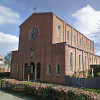Church and Parish
The text of the history section is from the Parish History, written by Des Keohane. The printed version is available from the Church for £3.50 and may be requested by post, at extra cost for postage. Any amendments or additions are welcomed – please send by email to Fr Andrew
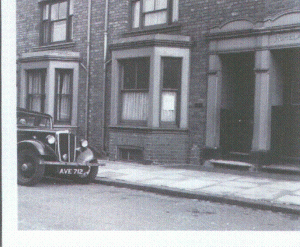 In October 1946 Father Phillips moved into the sparsely furnished presbytery at 68 Ashburnham Road. Mass continued to be offered in the Parish Rooms of the Anglican church. His wish, of course, was to expedite the erection on the Park Avenue site of the hut, which had been purchased for use as a temporary church in the previous March. However, under the prevailing building restrictions, the construction work required the issue of a license from the regional office in Nottingham, and this was still awaited. Father Phillips had a deep devotion to the Blessed Virgin, and a Novena to Our Lady of Perpetual Succour was started to seek her help, and on the 27 October, the final day of the Novena, the license to build arrived.
In October 1946 Father Phillips moved into the sparsely furnished presbytery at 68 Ashburnham Road. Mass continued to be offered in the Parish Rooms of the Anglican church. His wish, of course, was to expedite the erection on the Park Avenue site of the hut, which had been purchased for use as a temporary church in the previous March. However, under the prevailing building restrictions, the construction work required the issue of a license from the regional office in Nottingham, and this was still awaited. Father Phillips had a deep devotion to the Blessed Virgin, and a Novena to Our Lady of Perpetual Succour was started to seek her help, and on the 27 October, the final day of the Novena, the license to build arrived.
The erection work was undertaken by Underwood & Weston, then of Lady’s Lane, coincidentally but happily, a road with many medieval associations with the Faith. An unusually bad winter slowed the work, but by Spring 1947 it was nearing completion. To give greater height to the hut and to improve its suitability for use as a church, it was mounted on low base walls. On the night of 16 March, Northampton experienced one of the most violent storms in living memory, and the hut was lifted clear off its base. This was a distressing setback, but the damage was repaired and work continued both externally and internally. An entrance façade of brick and a brick porch were added to enhance the appearance and give protection from the weather. By the end of April, it was ready to serve as a temporary church.
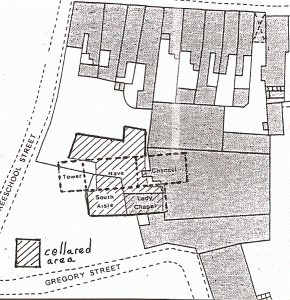 The church which Bishop Riddell had earlier proposed for the Whitworth Road site was to have been dedicated to St. Joseph but, as the Chapel at Notre Dame was already dedicated to Joseph, Bishop Parker decided that the new temporary church should be dedicated to St. Gregory the Great. Two factors made this dedication a truly fitting one: there was no other church in the diocese dedicated to the great Pope who had promoted the conversion of England, and it revived an interesting historical association between medieval Northampton and St. Gregory. For some 500 years, a church dedicated to St. Gregory stood on a site behind the south side of Marefair, an area bounded by Gregory Street and Free School Street, which is now mainly car parks (left). This church became well-known in medieval times for The Rood-in-the-Wall. A rood or crucifix, according to legend, was found by an English pilgrim to the Holy Land, near to where Jesus had been crucified, and he was told by an angel that it should be placed at the centre of the land of his birth.The pilgrim, on returning to England, sought to fulfill this instruction and in due course arrived at the old St Gregory’s church. With further angelic advice, he gave the crucifix to the church and it was erected in the wall. Not quite the centre of England but an angelic near miss! The church fell into disrepair and the Rood disappeared but, as shall be seen, our present St. Gregory’s church has initiated tangible links to its medieval predecessor.
The church which Bishop Riddell had earlier proposed for the Whitworth Road site was to have been dedicated to St. Joseph but, as the Chapel at Notre Dame was already dedicated to Joseph, Bishop Parker decided that the new temporary church should be dedicated to St. Gregory the Great. Two factors made this dedication a truly fitting one: there was no other church in the diocese dedicated to the great Pope who had promoted the conversion of England, and it revived an interesting historical association between medieval Northampton and St. Gregory. For some 500 years, a church dedicated to St. Gregory stood on a site behind the south side of Marefair, an area bounded by Gregory Street and Free School Street, which is now mainly car parks (left). This church became well-known in medieval times for The Rood-in-the-Wall. A rood or crucifix, according to legend, was found by an English pilgrim to the Holy Land, near to where Jesus had been crucified, and he was told by an angel that it should be placed at the centre of the land of his birth.The pilgrim, on returning to England, sought to fulfill this instruction and in due course arrived at the old St Gregory’s church. With further angelic advice, he gave the crucifix to the church and it was erected in the wall. Not quite the centre of England but an angelic near miss! The church fell into disrepair and the Rood disappeared but, as shall be seen, our present St. Gregory’s church has initiated tangible links to its medieval predecessor.
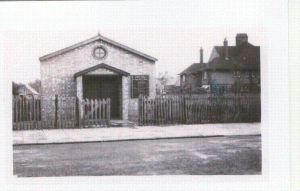 The first Mass in the new St. Gregory’s was offered by Bishop Leo Parker at 7.30 in the morning of May 1st 1947. At 8 pm the same evening the church was officially opened by the Bishop, who then conducted Solemn Benediction. This was a joyful occasion, particularly for those who had worked and prayed over many years for a Catholic church in Abington. The restricted accommodation made it necessary for admission to the opening ceremony to be by ticket only. On 27 September the Bishop returned once more: this time to formally inaugurate the new Parish of St. Gregory the Great, and to induct Father Eric Phillips as its Parish Priest. This marks the official beginning of our parish.
The first Mass in the new St. Gregory’s was offered by Bishop Leo Parker at 7.30 in the morning of May 1st 1947. At 8 pm the same evening the church was officially opened by the Bishop, who then conducted Solemn Benediction. This was a joyful occasion, particularly for those who had worked and prayed over many years for a Catholic church in Abington. The restricted accommodation made it necessary for admission to the opening ceremony to be by ticket only. On 27 September the Bishop returned once more: this time to formally inaugurate the new Parish of St. Gregory the Great, and to induct Father Eric Phillips as its Parish Priest. This marks the official beginning of our parish.
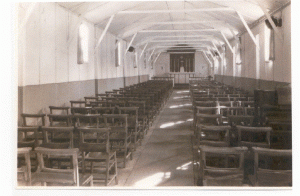 On each of these memorable occasions Father Phillips was at pains to emphasise that the new church was a temporary church, for he and his new parishioners were already working for a permanent building. The need was very soon demonstrably apparent. The temporary church was exceedingly small: 91 feet in overall length, 16 feet wide and 14 feet centre height with a third of it needed to accommodate the sanctuary and a small sacristy. It seated 180, and it could be very cold in winter and sometimes stiflingly hot in summer. However, it was a truly parish church and a strong sense of community developed.
On each of these memorable occasions Father Phillips was at pains to emphasise that the new church was a temporary church, for he and his new parishioners were already working for a permanent building. The need was very soon demonstrably apparent. The temporary church was exceedingly small: 91 feet in overall length, 16 feet wide and 14 feet centre height with a third of it needed to accommodate the sanctuary and a small sacristy. It seated 180, and it could be very cold in winter and sometimes stiflingly hot in summer. However, it was a truly parish church and a strong sense of community developed.
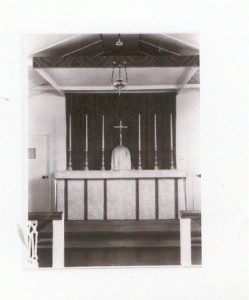 The energy and commitment of the new Parish Priest is evidenced by the attention he gave to the spiritual needs of his parishioners. Sunday Mass was offered in St. Gregory’s at 8.30, 9.30 and 11, and offered as well as a public house in Moulton at 9.45; Children’s Instruction at 3 pm; Compline, Sermon, and Benediction at 6.30; daily weekday Mass at 7.30 am, mid-week Benediction, three Confession sessions on Saturdays; pastoral care of St. Andrew’s Hospital (where Mass was also said), St. John’s Hospital and Manfield Orthopaedic Hospital. The very first First Communion Mass for the children at St. Gregory’s was held as early as June 1947. He was given permanent help, in August 1948, by the appointment of Father Maunsell as Assistant Priest, succeeded in the following year by Father Jenkinson, and in 1950 by Father Chapman. The Presbytery in Ashburnham Road soon proved too small and in 1948 a new Presbytery was purchased at 55 Park Avenue North, a little distance from the church and on the opposite side of the road.
The energy and commitment of the new Parish Priest is evidenced by the attention he gave to the spiritual needs of his parishioners. Sunday Mass was offered in St. Gregory’s at 8.30, 9.30 and 11, and offered as well as a public house in Moulton at 9.45; Children’s Instruction at 3 pm; Compline, Sermon, and Benediction at 6.30; daily weekday Mass at 7.30 am, mid-week Benediction, three Confession sessions on Saturdays; pastoral care of St. Andrew’s Hospital (where Mass was also said), St. John’s Hospital and Manfield Orthopaedic Hospital. The very first First Communion Mass for the children at St. Gregory’s was held as early as June 1947. He was given permanent help, in August 1948, by the appointment of Father Maunsell as Assistant Priest, succeeded in the following year by Father Jenkinson, and in 1950 by Father Chapman. The Presbytery in Ashburnham Road soon proved too small and in 1948 a new Presbytery was purchased at 55 Park Avenue North, a little distance from the church and on the opposite side of the road.
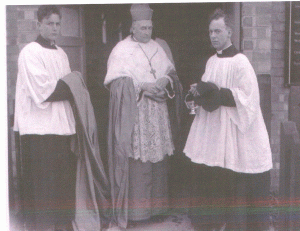 Father Phillips’s love of the liturgy in its full grandeur ensured that, despite cramped conditions in the temporary church, Sung Mass was offered on Sundays in a manner equal to that of many a far larger church. He had a dedicated MC in Leo Boullemier and a growing number of altar servers. A harmonium was an early purchase, and a choir was recruited and trained by the organist, Tony Haynes.
Father Phillips’s love of the liturgy in its full grandeur ensured that, despite cramped conditions in the temporary church, Sung Mass was offered on Sundays in a manner equal to that of many a far larger church. He had a dedicated MC in Leo Boullemier and a growing number of altar servers. A harmonium was an early purchase, and a choir was recruited and trained by the organist, Tony Haynes.
The commitment of the Parish Priest was matched by that of the parishioners. Altar cloths and vestments were handmade, and furniture for the presbytery was donated. Volunteers ensured that parish life was socially enriched with social evenings, Christmas Fairs, Bring and Buy sales and activities for the youth. The Abington Parish Rooms and the Community Centre in Wheatfield Road were regularly used as venues.
However, in 1950 the Diocesan Magazine reported: “The church … is unhealthily (or healthily?) overcrowded, and it frequently happens that some of the people have to hear mass outside the door; in the winter this is apt to be a wet and draughty experience!” The need for a permanent church was clearly there. To achieve it would not be easy. The challenges were threefold: finance, continuing post-war building restrictions and the choice of a suitable design. All three, of course, were interrelated.
